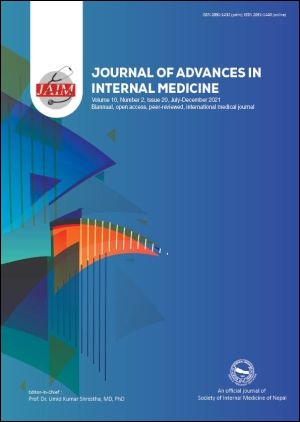Neurological manifestations of COVID-19: A literature review
DOI:
https://doi.org/10.3126/jaim.v10i2.42199Keywords:
Brain, COVID-19, Neurological Manifestation, SARS-CoV-2Abstract
A novel coronavirus that started from the Wuhan province of China is affecting the whole world. As of this date, more than 222 million cases are reported with more than 4.60 million fatalities. Nepal has more than 771,000 cases reported with almost 11,000 death recorded to date. Though most of the patients present with flu-like symptoms, people with comorbidities like Diabetes mellitus, hypertension, lung, and heart disease most likely suffer from severe disease and even death. As reported, neurological manifestations are common in critically ill patients. The most common manifestation of CNS is headache, dizziness, and encephalopathy whereas loss of smell and taste is the common PNS manifestation. Other neurological complications seen are fatigue, myalgias, hemorrhage, altered consciousness, Guillain-Barre Syndrome, syncope, seizure, and stroke. Non-specific neurological symptoms may be present in the early stages which can mislead the treatment. In some cases, neurological manifestations precede the typical presentation of fever, cough, and shortness of breath and later develop into typical features. The virus enters the brain through 2 systems: hematogenous route or olfactory route. Angiotensin-converting enzyme-2 (ACE-2) is the port of entry to the brain for COVID- 19(SARS-CoV-2) which was also the entry point for SARS-CoV. Covid-19 cases are increasing in the world and prevention and control of spread are a must. Understanding the neurological invasion pathogenesis, and manifestation will help the neurologists and physicians on frontlines to recognize early cases with nervous system involvement, neurological complications, and sequelae during and after the pandemic.
Downloads
Downloads
Published
How to Cite
Issue
Section
License
Copyright (c) 2021 Suman Adhikari, Prabin Bhandari, Naresh Poudel, Nikunj Yogi, Balgopal Karmacharya, Asmita Dhakal

This work is licensed under a Creative Commons Attribution 4.0 International License.
This license enables reusers to distribute, remix, adapt, and build upon the material in any medium or format, so long as attribution is given to the creator.




